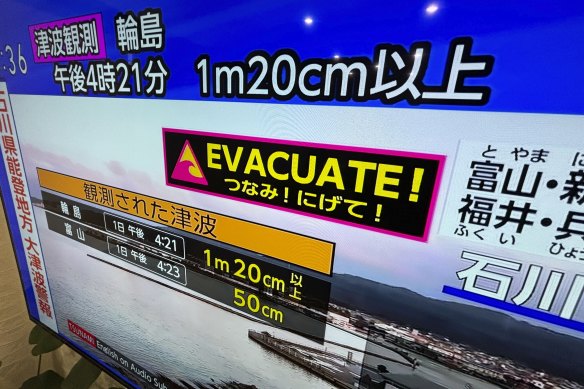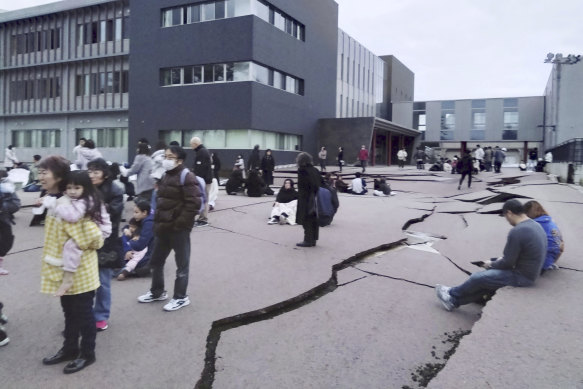Updated January 1, 2024 — 9.11pm
A powerful earthquake struck central Japan and its western coast on Monday, triggering tsunami warnings, knocking out power to thousands of homes and disrupting flights and rail services.
The most powerful in a series of quakes shortly after 4pm local time recorded a preliminary magnitude of 7.6. The Japan Meteorological Agency issued tsunami warnings for the coastal prefectures of Ishikawa, Niigata and Toyama.
Tsunami waves of around 1 metre along parts of the Sea of Japan coast were recorded. The public broadcaster NHK TV reported that larger waves were expected.
Russia also issued tsunami warnings in its far eastern cities of Vladivostok and Nakhodka, while South Korea’s Gangwon province warned residents to take precautions and evacuate to higher ground.
NHK TV warned torrents of water could reach as high as 5 metres and urged people to flee to higher ground or to the tops of nearby buildings.
NHK said the tsunami waves could keep returning, and the warnings were repeatedly aired nearly an hour after the initial alert.
Japan issues tsunami warnings after a series of very strong earthquakes in the Sea of Japan.Credit: AP
Authorities were still assessing the extent of the earthquake damage and residents needed to prepare for further tremors, Prime Minister Fumio Kishida said in comments aired on NHK.
“Residents need to stay on alert for further possible quakes and I urge people in areas where tsunamis are expected to evacuate as soon as possible,” Kishida said.
The meteorological agency said the primary earthquake’s magnitude of 7.6 was the largest in the Noto peninsula region of Ishikawa since 1885 – the year data was first recorded.
Cracks in the ground in Wajima, Ishikawa prefecture on Monday.Credit: Kyodo News
Footage aired by NHK showed a building collapsing in a plume of dust in the coastal city of Suzu and residents in Kanazawa city cowering under tables as tremors shook their homes. The quake also jolted buildings in the capital Tokyo on the opposite coast.
More than 36,000 households had lost power in Ishikawa and Toyama prefectures, utilities provider Hokuriku Electric Power said.
High-speed rail services to Ishikawa were suspended while telecom operators Softbank and KDDI reported phone and internet service disruptions in Ishikawa and Niigata, according to their websites.
Japanese airline ANA turned back four planes headed to airports in Toyama and Ishikawa following the quake, while Japan Airlines cancelled most of its services to the Niigata and Ishikawa areas for the rest of the day, according to TV Asahi.
Japan’s Nuclear Regulation Authority said no irregularities had been confirmed at nuclear power plants along the Sea of Japan, including five active reactors at Kansai Electric Power’s Ohi and Takahama plants in Fukui Prefecture.
Hokuriku’s Shika plant in Ishikawa, which was located the closest to the quake’s epicentre, had already halted its two reactors before the quake for regular inspection and saw no impact from the quake, the agency said.
A huge earthquake and tsunami struck north-eastern Japan on March 11, 2011, killing nearly 20,000 people, devastating towns and triggering nuclear meltdowns in Fukushima.
Loading
Another quake, known as the Great Hanshin Earthquake, hit western Japan in 1995, killing more than 6000 people, mainly in the city of Kobe.
AP, Reuters
Get a note directly from our foreign correspondents on what’s making headlines around the world. Sign up for our weekly What in the World newsletter.
Most Viewed in World
Loading
>>> Read full article>>>
Copyright for syndicated content belongs to the linked Source : The Sydney Morning Herald – https://www.smh.com.au/world/asia/japan-issues-tsunami-warnings-after-a-series-of-strong-earthquakes-20240101-p5eulh.html?ref=rss&utm_medium=rss&utm_source=rss_feed

































